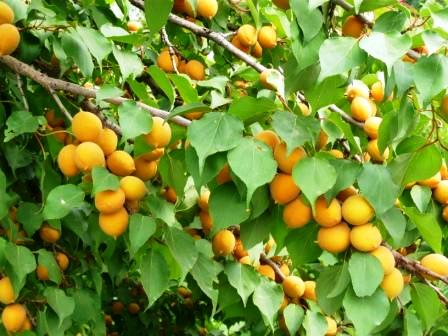Apricot is a light-insulated plant that does not like shading. It is recommended to plant it on a plot with fertile and northern winds protected from the eastern and northern winds, as well as light in composition and weakness soil. At the same time, the groundwater occurrence should be about 2 m.
Content
As for heavy and highly moistened soils, they are not at all suitable for apricot.
For good pollination, its flowers in the garden should be from 2 trees of different varieties, which are at a distance of 3 m from each other.
Landing apricot
The best apricot landing period is April, because the plant early starts to vegetate. In a specially designated place, 1-2 summer apricot seedlings with a well-developed root system should be positioned.
Poons of the pit on thin fertile soils are 70 × 70 cm, and on the poor - 1 × 0.7 m. If your garden has a sandy soil, then it is necessary to lay a layer of clay in 20 cm on the bottom - in this way, you will contribute to the detention of water.
Next, it is necessary to make up to 30 kg to the landing pit, which is pre-mixed with mineral fertilizers (potassium chloride, superphosphate or wood ash). As for acidic soils, they are lime in advance.
Then, the fertile top layer of the Earth, mixed with mineral fertilizers, pour into the bottom in the form of a holloch. The center is necessarily driven by a 1.5-meter landing amount, and the roots of the tree are distributed on the sides. The root neck should be opened by about 5 cm. After planting a plant is made, it is necessary to rush to water with water (20-30 liters), and the soil is closed around with beveled grass, dry ground or peatkin.
Growing apricot
The main care for the apricot tree consists in regular feeding, watering, soil looser and weeding. Young plants are recommended to water up to 4-5 times per season, using 20-30 liters of water for each. As for nitrogen fertilizers, they are recommended to be made in March and June under young cultures in the amount of 30 g per 1 sq.m.
After feeding, the dry ground is loose and abundantly moisturized, and its surface is mulched.
In the fall, you need to take care of organic fertilizer, potash and phosphorus, which are made under shabby soil replenishment.
As for the fruitful trees, they need nitrogen fertilizers and superphosphate, which are entered in early spring before the flowering of apricot and immediately after the first wave of the wound out.
In order to protect the base of the branches and the strains from the early spring burns, they should be blued in the fall.
How to Protect Apricot Flowers
As Apricot is an early plant that begins to bloom immediately after the appearance of the first warm days, it must be protected from spring frosts.
The best method in this case is the shelter in 2 layers of crowns by agricultural or other than any cloth for a period of flowering. In the corners, the material is fixed to the branches in such a way that insects can pollinate the plant without free.
Recommendations:
In order to attract the insects beneficial to the plant, before the shelter should be chopped by the tree and its flowers with a solution of honey.
Pests and diseases: how to deal
If the summer got good with moderately windy, warm and sunny weather, the apricot is practically not amazed by pests and diseases, but the plant may begin to suffer from abroad and moniliosis in cloudy and cold weather.
At the first signs of any disease, the tree and its foliage, it is necessary to immediately treat topxin-m, chlorokising copper, strobe, topaz and other drugs. At the same time, it is necessary to add soap to the solution. If the culture was damaged by sipproke and aphids, then they can be eliminated by inta-virus, decis and other means, again with the addition of soap.
As for agrotechnical methods of struggle, experts apply the following:
- construct around the garden well ventilated fences;
- regularly collect dried and damaged fruits, and sick branches are cut off;
- create timely mulching of the soil, its loosening, feeding and watering;
- every year make trimming trees so that they are unguarded and small-grained.
Formation of trees
In order not to make apricot in winter, it is necessary to produce the formation of strong shoots that have a length of more than half a meter.
In the first days of August 1/3 of the length of the powerful, not yet a weed escape, bend into a semiring or ring, and are tied up with a wire, which is then removed in the spring in the spring.
Thanks to the forming, the tree decreases in size, the laying of fruit kidneys and their fruiting are accelerated, and the conditions for good aging and growth of shoots are also created.
Forming recommendations:
The bent shoots of the tree must be with an interval of 70-50 cm in the crown of the tree and have good lighting. As for weak unnecessary shoots, it is possible to remove up to 3 cm.
How to trim apricot
Apricot Pruning Rules:
- each sheet of wood should be well covered;
- intertwing branches growing inside the crowns, as well as those that are very close to each other should be shocked or cut into the ring;
- branches having the angles of fatigue less than 50 ° are cut onto the ring;
- the tree must have a small crown of 3-4 m.
Apricot. Landing, cultivation and care video:




























